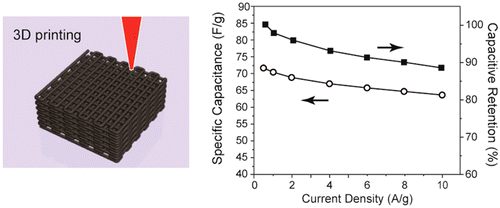
Researchers at UC Santa Cruz have developed a method of 3D printing graphene electrodes that could revolutionize the way we power mobile devices.
Graphene is a form of carbon that exhibits unusually good electrical properties, and researchers have been searching for ways to create effective electrical storage devices with it. One method is to produce an aerogel with graphene, but such attempts have been limited by the internal structure of the aerogel that creates inefficiencies.
The researchers have managed to overcome this challenge by 3D printing the graphene composite aerogel, which permits direct control over the internal structure. They explain the results:
The 3D-printed graphene composite aerogel (3D-GCA) electrodes are lightweight, highly conductive, and exhibit excellent electrochemical properties. In particular, the supercapacitors using these 3D-GCA electrodes with thicknesses on the order of millimeters display exceptional capacitive retention (ca. 90% from 0.5 to 10 A·g–1) and power densities (>4 kW·kg–1) that equal or exceed those of reported devices made with electrodes 10–100 times thinner.
Why is this important? Because capacitors are very different than batteries: they can be charged extremely quickly, sometimes requiring only seconds to hit full capacity! Imagine how the use of mobile devices might change if this capability were widespread.
What I find most fascinating about this development is how it fits so well into the 3D printing design paradigm: custom shapes.
In the case of mobile devices, they typically get smaller each year, packing more electronic capability into a smaller case volume. This has been constrained by the size and bulk of the battery. Consider that the new supercapacitor technology not only produces highly efficient portable power, but through the use of 3D printing, it can be made into any required shape!
Thus, new mobile devices could eventually be designed with far fewer constraints driven by battery shape and volume. Supercapacitors could be produced that precisely fit the unused volume of a small mobile device, optimizing the volume.
It’s also possible that with a device that can charge very quickly, there may be less need for energy capacity overall. When you don’t have to wait two hours for a charge, you might be less interested in the charge duration.
Via Santa Cruz Sentinel and Nanoletters

